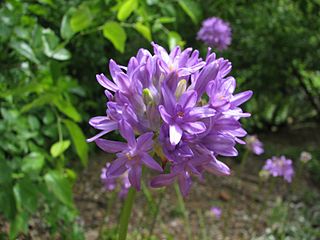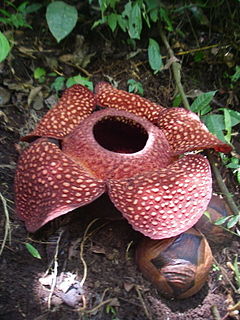
Rafflesia is a genus of parasitic flowering plants. It contains approximately 28 species, all found in Southeast Asia, mainly in Indonesia, Malaysia, Thailand and the Philippines. It was first discovered by Louis Deschamps in Java between 1791 and 1794, but his notes and illustrations, seized by the British in 1803, were not available to western science until 1861. It was later found in the Indonesian rainforest in Bengkulu, Sumatra by an Indonesian guide working for Joseph Arnold in 1818, and named after Sir Stamford Raffles, the leader of the expedition.

The Araceae are a family of monocotyledonous flowering plants in which flowers are borne on a type of inflorescence called a spadix. The spadix is usually accompanied by, and sometimes partially enclosed in, a spathe or leaf-like bract. Also known as the arum family, members are often colloquially known as aroids. This family of 114 genera and about 3750 known species is most diverse in the New World tropics, although also distributed in the Old World tropics and northern temperate regions.

Oden (おでん) is a type of nabemono, consisting of several ingredients such as boiled eggs, daikon, konjac, and processed fishcakes stewed in a light, soy-flavored dashi broth.
Corpse plant is a common name for several flowering plants and may refer to:
Voodoo lily is a common name for several plants and may refer to:

The Muttart Conservatory is a botanical garden located in the North Saskatchewan river valley, across from the downtown core in Edmonton, Alberta, Canada. One of the best-known landmarks of Edmonton, the conservatory consists of three city-operated greenhouses, public gardens, as well as four feature pyramids for display of plant species found across three biomes, with the fourth pyramid hosting as a seasonal display. A fifth minor skylight pyramid lights up the central foyer.

Carrion flowers, also known as corpse flowers or stinking flowers, are flowers that emit an odor that smells like rotting flesh. Carrion flowers attract mostly scavenging flies and beetles as pollinators. Some species may trap the insects temporarily to ensure the gathering and transfer of pollen.
Penis plant is a common name for several plants and may refer to:
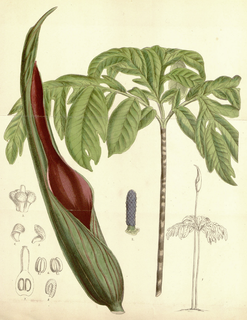
Dracontium is a genus of flowering plants similar to those of Amorphophallus. Unlike Amorphophallus which is found in the Old World, this genus has a New World distribution and is native to South America, Central America, southern Mexico, and the West Indies.

Shirataki(白滝, often written with the hiragana しらたき) are thin, translucent, gelatinous traditional Japanese noodles made from the konjac yam. The word "shirataki" means white waterfall, referring to the appearance of these noodles. Largely composed of water and glucomannan, a water-soluble dietary fiber, they are very low in digestible carbohydrates and calories, and have little flavor of their own.
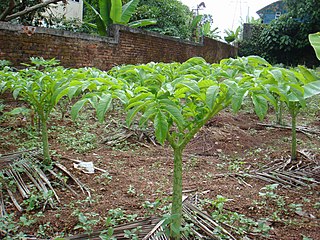
Amorphophallus paeoniifolius, the elephant foot yam or whitespot giant arum, is a tropical tuber crop grown primarily in Africa, South Asia, Southeast Asia and the tropical Pacific islands. Because of its production potential and popularity as a vegetable in various cuisines, it can be raised as a cash crop.

Amorphophallus abyssinicus, also known as Bagana (Sidamo), is a plant of the genus Amorphophallus. It is native to southern Ethiopia, where it is grown in gardens, hence its specific epithet, abyssinicus, derived from Latin and meaning "Abyssinian" or "Ethiopian".
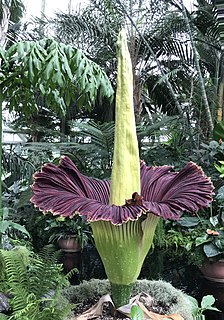
Amorphophallus titanum, also known as the titan arum, is a flowering plant with the largest unbranched inflorescence in the world. The titan arum's inflorescence is not as large as that of the talipot palm, Corypha umbraculifera, but the inflorescence of the talipot palm is branched rather than unbranched. The species is endemic to Sumatra.
Devil's tongue another name for konjac, a flowering plant of genus Amorphophallus. It may also refer to:
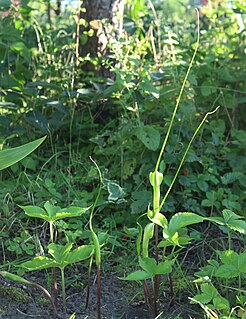
Pinellia tripartita is a species of Pinellia in the Arum family (Araceae). Purported common names include green dragon and voodoo lily. A purple variety goes by purple dragon. It is found in Japan, including Okinawa, the Korean peninsula, and infrequently in eastern China.
Amorphophallus mekongensis is a species of tuberous plant in the family Araceae. It can be found in Vietnam & Laos; in Viet Nam it is called nưa Cửu Long. No subspecies are listed in the Catalogue of Life.
This page is based on this
Wikipedia article Text is available under the
CC BY-SA 4.0 license; additional terms may apply.
Images, videos and audio are available under their respective licenses.


